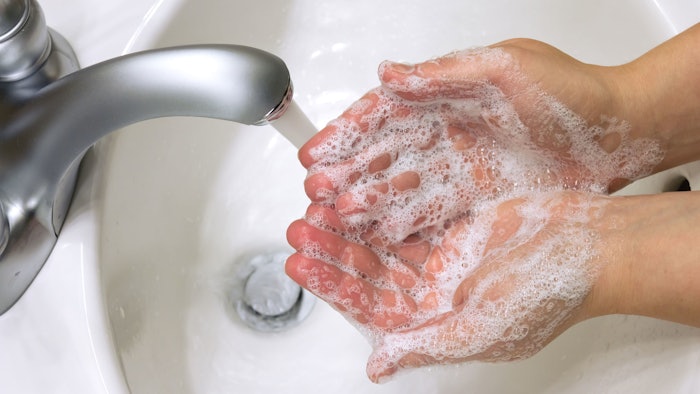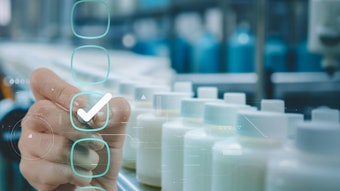
A letter submitted to the U.S. Food and Drug Administration (FDA) by the Green Science Policy Institute (GSPI) NGO urges the agency to ban three antibacterial hand soap ingredients, citing safety concerns. The GSPI referenced a study published in Environmental Science & Technology in 2023 (co-authored by GSPI), highlighting quaternary ammonium compounds (QACs) as a "chemical class of emerging concern." The ingredients in question are two QACs: benzalkonium chloride (BAC) and benzethonium chloride (BZT); and the organohalogen chloroxylenol (PCMX) — which have been awaiting the FDA's ruling for more than a decade. Could this delay be exposing consumers to potential risk? The GSPI thinks so. It certainly exposes the industry to new scrutiny; just look at what happened with UV filters.
Log in to view the full article
A letter submitted to the U.S. Food and Drug Administration (FDA) by the Green Science Policy Institute (GSPI) NGO urges the agency to ban three antibacterial hand soap ingredients, citing safety concerns. The GSPI referenced a study published in Environmental Science & Technology in 2023 (co-authored by GSPI), highlighting quaternary ammonium compounds (QACs) as a "chemical class of emerging concern." The ingredients in question are two QACs: benzalkonium chloride (BAC) and benzethonium chloride (BZT); and the organohalogen chloroxylenol (PCMX) — which have been awaiting the FDA's ruling for more than a decade. Could this delay be exposing consumers to potential risk? The GSPI thinks so. It certainly exposes the industry to new scrutiny; just look at what happened with UV filters.
FDA in Holding Pattern
In response to comments by the industry, the FDA deferred rulemaking on the ingredients for one additional year to allow the industry to submit safety and effectiveness data. ...It extended a 2016 deferral several times and has still not reached a decision."
The proposal to ban the named ingredients is not news to the FDA — it's been eyeing these ingredients for more than ten years. In 2013, the FDA requested additional data from manufacturers on the safety and effectiveness of certain ingredients used in over-the-counter (OTC) consumer antibacterial washes, including BAC, BZT and PCMX. This was because other data suggested that long-term exposure to certain active ingredients used in antibacterial products — especially triclosan (liquid soaps) and triclocarban (bar soaps) — could pose health risks including bacterial resistance or hormonal effects.
In 2016, the agency issued a final rule on the safety and efficacy of 19 antimicrobial ingredients used in antibacterial soaps, stating, "Companies will no longer be able to market antibacterial washes with these ingredients because manufacturers did not demonstrate that the ingredients are both safe for long-term daily use and more effective than plain soap and water...." It added, at that time, that some manufacturers had already started removing these ingredients from their products.
BAC, BZT and PCMX were not among the banned, however. In response to comments by the industry, the FDA deferred rulemaking on the ingredients for one additional year to allow the industry to submit safety and effectiveness data for these ingredients. During that year (2016-2017), consumer antibacterial washes containing these specific ingredients were permitted to be marketed.
The GSPI reiterated, "The agency said there was no data to 'demonstrate that there is any additional benefit from the use of these active ingredients in consumer antiseptic wash products, compared to nonantibacterial soap and water.' However, due to industry pressure, the FDA delayed their decision on benzalkonium chloride, benzethonium chloride and chloroxylenol. The FDA then extended the 2016 deferral several more times and has still not reached a decision."
Reproductive, Respiratory, Microbial Resistance and Other Concerns
The GSPI's letter, co-signed by more than 40 environmental and health organizations, states that QACs, "have been linked to reproductive, respiratory, skin and neurological harms and may contribute to the global health threat of antimicrobial resistance." Furthermore, it adds, "All well-studied organohalogens have been found to be harmful to people, ecosystems and especially to children," referring to chloroxylenol.
"The agency was due to make its decision eight years ago. ... During this delay, evidence has grown on the health harms — but not the effectiveness — of these chemicals," the letter states. Arlene Blum, executive director of GSPI explains. "Adding these antimicrobials to soaps isn’t doing anything to protect us from flu or COVID. Instead, the chemicals can contribute to antimicrobial resistance, asthma, reproductive and developmental harm. This is particularly of concern for babies and children.”
The FDA, in some ways, agrees. "There isn’t evidence to show that over-the-counter (OTC) antibacterial soaps are better at preventing illness than washing with plain soap and water," the FDA website states. "In fact, some data suggests that antibacterial ingredients could do more harm than good over the long-term."
'Skyrocketing' Use of Controversial Ingredients
“The FDA’s ruling on these chemicals is eight years overdue,” said Eve Gartner, director of Crosscutting Toxics Strategies at Earthjustice. “The agency’s foot-dragging has enabled the use of these ingredients in hand soaps to skyrocket, despite manufacturers’ failure to present evidence of their safety or utility. It’s past time for the FDA to act to stop the harm.”
Indeed, according to Market Research Future, the benzalkonium chloride market was valued at US $521 million in 2020 and is projected to reach $650 million by 2027 (CAGR of 8.1%), driven in part by the personal care and cosmetics segment. Markets & Data estimates the global chloroxylenol market will expand but to a lesser degree. The firm estimates a CAGR 3.5% from 2024-2031, growing from $151.3 million in 2023 to $199.23 million in 2031. "The market expansion is supported by increasing usage of personal care products and cosmetics, rising pharmaceutical applications and others," Markets & Data states. (We were unable to obtain data on benzethonium chloride).
The GSPI's letter explicitly states, "We are concerned that QACs continue to be widely used in over-the-counter consumer antiseptic washes, including by children (many of whom use antiseptic washes daily – at home and in school) – despite the absence of data that they are GRAE or GRAS, and in the absence of FDA performing a “benefit-to-risk ratio” analysis to assess whether any benefit outweighs the health concerns, which is required by FDA’s rules."
It continues, "Questions about whether BAC, BZT and PCMX provide any antiseptic benefit loom large especially since the other 19 antimicrobials that were part of the 2016 final rule were found to be no more effective than non-antimicrobial soap and water. Meanwhile, the evidence of the health hazards linked to QACs including their possible contribution to antimicrobial resistance has only gotten stronger."
The letter adds that the fact that neither the safety nor the efficacy of the deferred antimicrobials has been established in the eight years the FDA has already given manufacturers may be indication that they are neither safe nor effective.
One industry expert agrees that the FDA should make a decision about these ingredients. "I don't necessarily believe [these ingredients] are doing the harm claimed by NGOs, but I do agree FDA should finalize or shut the monograph down," says regulatory expert Debbie Waite, of Steinberg & Associates."
Industry Conclusions and Opinions
Conclusions and opinions were previously issued regarding these ingredients by the Cosmetic Ingredient Review (CIR) expert panel in the U.S. and EU's Scientific Committee on Cosmetic Products and Non-food Products Intended for Consumers (SCCNFP) — the predecessor to the Scientific Committee on Consumer Safety (SCCS). They have deemed these ingredients to be safe at restricted concentrations.
The agencies state the following (reports provided where available).
Benzalkonium Chloride
- CIR: The CIR stated, in its most recent (2008) report: In a safety assessment of Benzalkonium Chloride (Elder 1989), the Cosmetic Ingredient Review (CIR) Expert Panel stated that Benzalkonium Chloride, at concentrations up to 0.1% free, active ingredient, is safe as a cosmetic ingredient as presently used. The Expert Panel reviewed newly available studies since that assessment, along with updated information regarding types and concentration of use, noting that these studies were similar to those already included in the original safety assessment and, therefore, raised no new safety issues. The Panel confirmed the safety of Benzalkonium Chloride at concentrations up to 0.1% free, active ingredient and did not reopen the safety assessment.
Benzethonium Chloride
- CIR: In its most recent (2006) report, the CIR outlined: A safety assessment of Benzethonium Chloride and Methylbenzethonium Chloride was published in 1985 with the conclusion that these ingredients are safe at concentrations of 0.5% in cosmetics applied to the skin, and up to 0.02% for cosmetics used in the eye area (Elder 1985). New studies, along with the updated information below regarding types and concentrations of use, were considered by the CIR Expert Panel. The Panel determined to not reopen this safety assessment.
- SCCNFP: In its most recent (2003) report, the SCCNFP stated: The data provided in the submitted dossier does not support the requested use of benzethonium chloride as a preservative in leave-on products. Its present use as a preservative in rinse-off products at a maximum authorized concentration of 0.1% is considered safe.
Chloroxylenol
- CIR: In its latest (2023) report, the CIR stated: The Expert Panel for Cosmetic Ingredient Safety reviewed updated information that has become available since their original assessment from 1985, along with updated information regarding product types, and frequency and concentrations of use, and reaffirmed their original conclusion that Chloroxylenol is safe as a cosmetic ingredient in the practices of use and concentration as described in this report.
The reported practices of use and concentration include: - 0.1-0.2% in leave-on products and
- 0.4-0.5% in rinse-off products.
Show Me the Data
By the looks of the dates on these reports, it's fairly safe to say it's been a while since data on the safety of ingredients has been presented, at least to these agencies or made publicly available. Is it a lack of data? If so, the industry needs to step up.
While it's difficult to say where ruling on these ingredients ranks within the FDA's priority list, as the GSPI points out, time is passing and consumers continue to use products containing these ingredients. The industry may agree the ingredients are safe at the outlined usage levels, but the FDA's delay exposes the industry to new scrutiny. Just look at the backlash from consumers with the delay of UV filter approvals. It's a recipe for trouble — beauty Sci-Commers better get to cooking up answers.
Editor's note: The FDA was approached for comment but has not yet responded.










